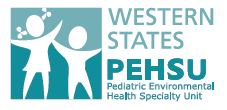This easy to administer environmental health curriculum, meets ACGME requirements, is adaptable to multiple sites, and doesn’t require expertise in environmental health to administer. The curriculum aims to teach pediatric residents proficiency in environmental health and establish a foundation of knowledge upon which they will expand during their careers.
The Community Environment
Downloads
Community Environment Module (pdf)
Faculty Guide (pdf)
Objectives
Appreciate how features of the neighborhood and community impact children’s health
- Physical design
- Access to health promoting resources
- Social structure
Introduction
A comprehensive view of a child’s life lends understanding of how a given risk affects a given child. An environmental health perspective helps the provider take this broad view as it allows exploration of the interplay between genetics, demographics, toxic exposures, positive influences, the built environment, chronic illness, maternal exposures, prior exposures, age, and behavior. These influences function at both the individual and community level. To appreciate the complex interplay of these influences at the community level, the pediatrician’s best tool is her observation skills. These skills, honed in the clinic, can help a pediatrician begin to understand how the built environment impacts children’s health.
Preparation
Before visiting the neighborhood, prepare by becoming familiar with key concepts in environmental health, key concepts of the built environment, and learn some of the characteristics of the neighborhood you will visit.
- Environmental hazards as they relate to children.
Read: Pediatric Environmental Health Toolkit: Key Concepts - The Built Environment and Health:
Review: AAP Committee on Environmental Health: “Statement on The Built Environment.” Pediatrics June 2009 - Your instructor with provide you with a patient to be considered during this exercise.
- Spend 20 minutes on Google and Google maps familiarizing yourself with the chosen neighborhood. Use the worksheet to mark important places on your Google map.
- Familiarize yourself with online tools for neighborhood evaluation. Learn about the pollutants in the zip code you have been given and how your patient’s neighborhood compares to others.
- Climate and Economic Justice Screening Tool: made by the President’s Council on Environmental Quality, this is a national map of disadvantaged communities including indicators for climate change, pollution, transportation, water and health among many others.
- CalEnviroScreen (California only): Census tract level percentile scores based on environmental health concerns, and demographic vulnerabilities.
- EPA Enviromapper Storefront: Interactive mapping tools for querying environmental information by zip code. It includes an environmental justice database.
- Air Quality Index: Check the local Air Quality Index and forecasts for air quality in your patient’s zip code.
- ATDSR ToxFAQs: Detailed information about hazardous wastes.
Neighborhood visit
Visit your patient’s neighborhood. Look for neighborhood features that impact children’s health. Use the worksheet to guide your thinking as you walk. Consider the relationship between your patient’s health and the greater community.
Fact Check
Download
Worksheet (pdf)
Objective
In this exercise you will practice using environmental health resources to critically evaluate mainstream publications. You will also become more familiar with current events in environmental health.
Primary Resources (in addition to Medline)
Pediatric Environmental Health Toolkit, Published by Physicians for Social Responsibility
Pediatric Environmental Health, Edited by Ruth Etzel, American Academy of Pediatrics
American Academy of Pediatrics Statements of the Committee on Environmental Health
ATDSR ToxFAQs: Frequently asked questions about contaminants.
http://www.epa.gov: You can query EPA information studies and fact sheets about human exposures.
Instructions
- Select a newspaper clipping, magazine article, blog, or website from mainstream media. It should be from within the past month.
- Using peer reviewed sources, review the basics of the topic discussed.
- Evaluate the information provided for accuracy and completeness.
Discussion
- How well did this source interpret environmental health science for the average reader?
- How could the accuracies and inaccuracies in the article effect patient behavior?
- How would you discuss this article with the patient?
- Is this new information? If so, should we consider new preventive messages in the clinic?
- Could this article impact the physician/patient relationship?
The Home Visit
Objective
In this exercise you will learn to perform a basic environmental health assessment and analyze your findings. You will also learn to give age appropriate anticipatory guidance using the Pediatric Environmental Health Toolkit (PEH Toolkit). This exercise will also help you become more familiar with environmental health topics and resources.
Preparation (Approximately 30 minutes)
Prior to visiting your patient;
- Review Chapter 4 and 5 in the AAP Green Book 2nd Ed.
- Review the PEH Toolkit materials.
- Read the Key Concepts in the PEH Toolkit.
During the Visit (Approximately 90 minutes)
Fill out the History and Home Inventory Form when visiting your patient.
Provide your patient with age appropriate anticipatory guidance about environmental health using the PEH Toolkit materials.
Using the History and Home Inventory Form:
In the first column are questions you must answer with either observation or history while at the patient’s home. In the next column, fill in your findings. In the final column, mark if the answer raises concerns about your patient’s health. In your assessment you will explore these concerns.
After the Visit (Approximately 90 minutes)
Write up your history and inventory using the Assessment Form and place it in the patient’s chart. Use the AAP Green Book to learn more about your patient’s environmental health concerns. Your plan should include preventive messages and recommended interventions you intend to share with the patient’s family. You may also want to identify ways to advocate for your patient’s environmental health.
At your next visit with the patient, discuss your assessment and plan with the family. Depending on your findings, you may want to make an appointment specifically for this discussion.
Useful Resources
The AAP Green Book: Pediatric Environmental Health 4th Edition
The Pediatric Environmental Health Toolkit
Designing Curriculum to Meet (ACGME) Requirements
Download
Worksheet (pdf)
Overall goal of program design:
Create a comprehensive Environmental Health Curriculum which meets ACGME requirements, can be adapted to multiple sites, and can be administered by pediatricians who are not experts in EH.


